Financial Feasibility of Virtual Reality Business in Malaysia
VerifiedAdded on 2022/11/25
|11
|2011
|314
AI Summary
This document discusses the financial feasibility of starting a virtual reality business in Malaysia, including sources and uses of funds, pro forma income statement and balance sheet, cash flow analysis, and ratio analysis.
Contribute Materials
Your contribution can guide someone’s learning journey. Share your
documents today.
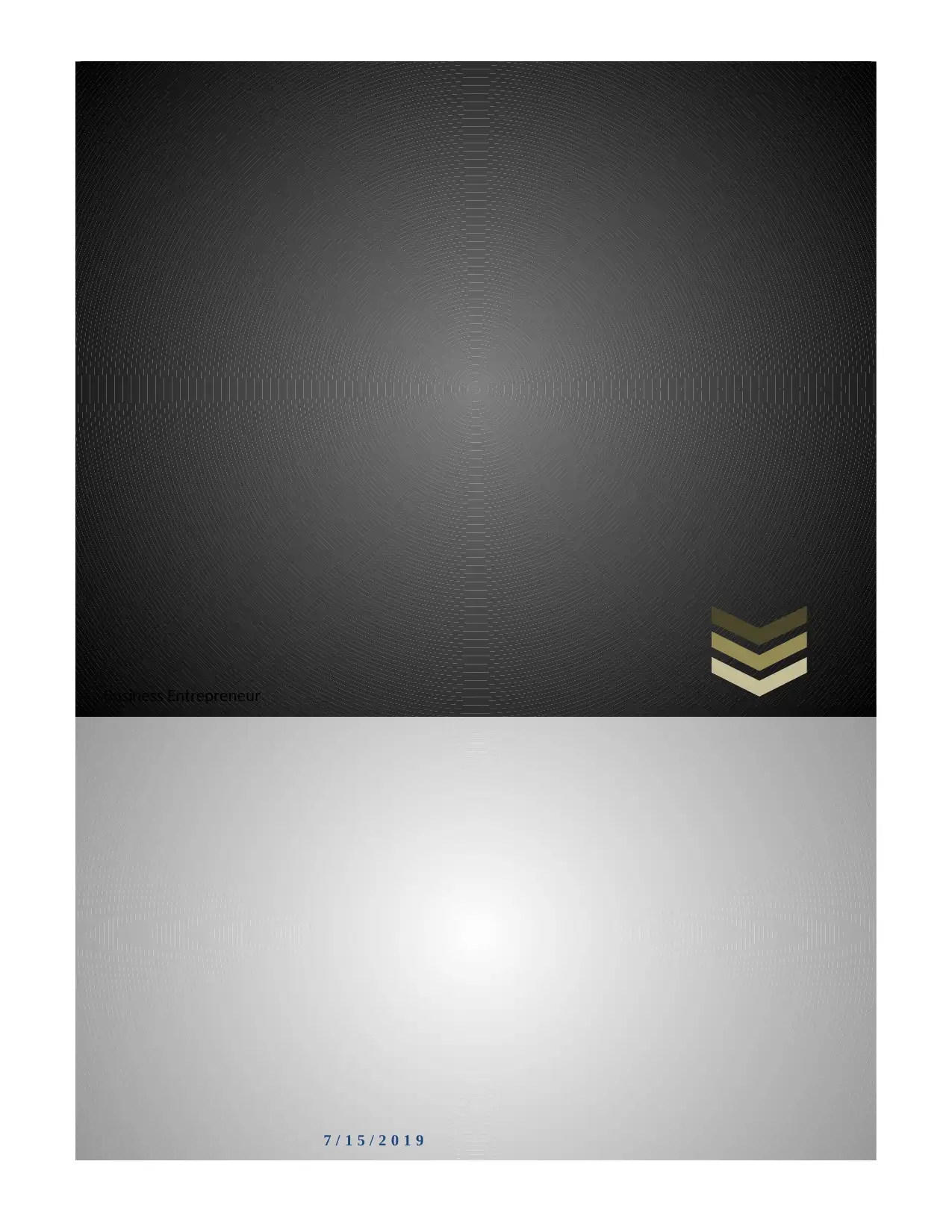
Business Entrepreneur
7 / 1 5 / 2 0 1 9
7 / 1 5 / 2 0 1 9
Secure Best Marks with AI Grader
Need help grading? Try our AI Grader for instant feedback on your assignments.
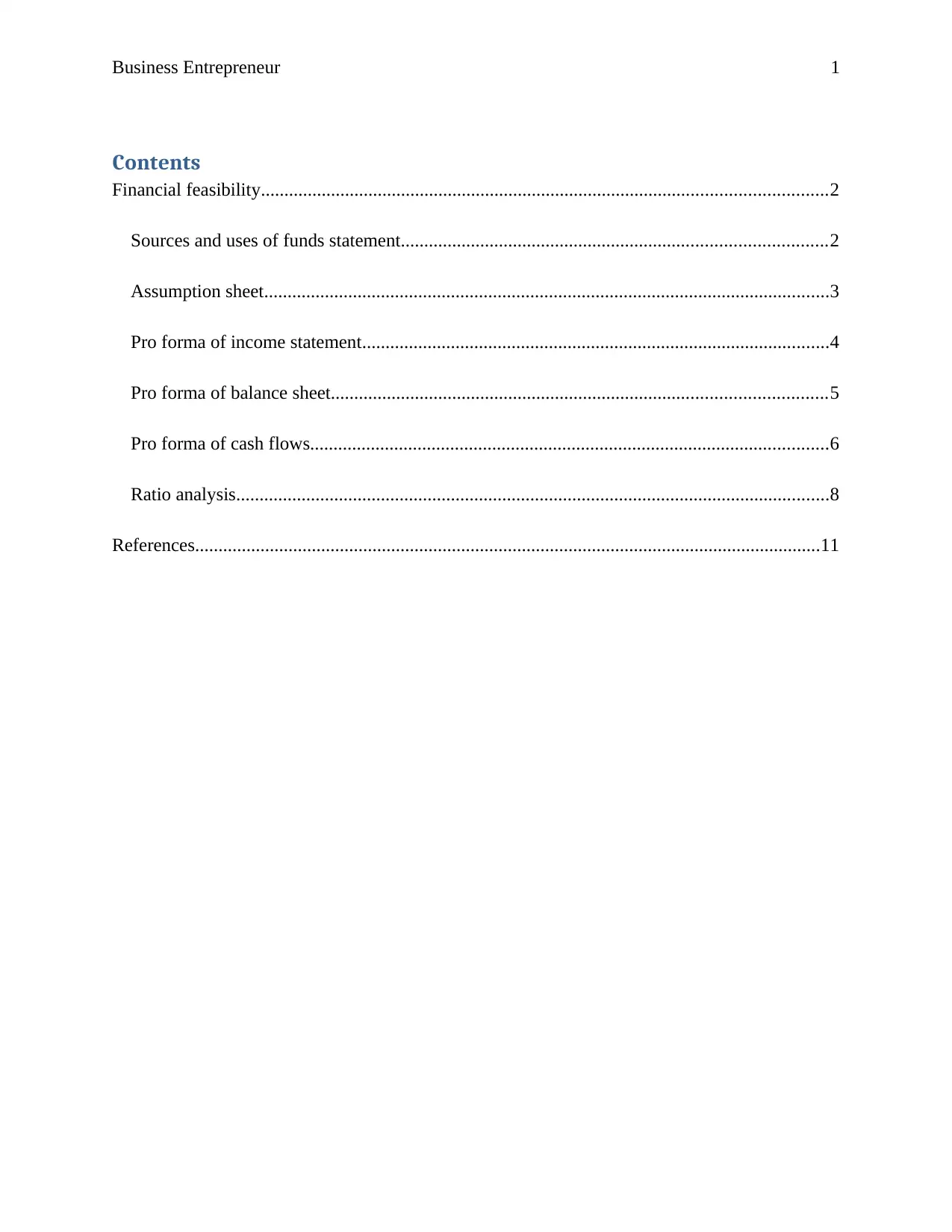
Business Entrepreneur 1
Contents
Financial feasibility.........................................................................................................................2
Sources and uses of funds statement...........................................................................................2
Assumption sheet.........................................................................................................................3
Pro forma of income statement....................................................................................................4
Pro forma of balance sheet..........................................................................................................5
Pro forma of cash flows...............................................................................................................6
Ratio analysis...............................................................................................................................8
References......................................................................................................................................11
Contents
Financial feasibility.........................................................................................................................2
Sources and uses of funds statement...........................................................................................2
Assumption sheet.........................................................................................................................3
Pro forma of income statement....................................................................................................4
Pro forma of balance sheet..........................................................................................................5
Pro forma of cash flows...............................................................................................................6
Ratio analysis...............................................................................................................................8
References......................................................................................................................................11
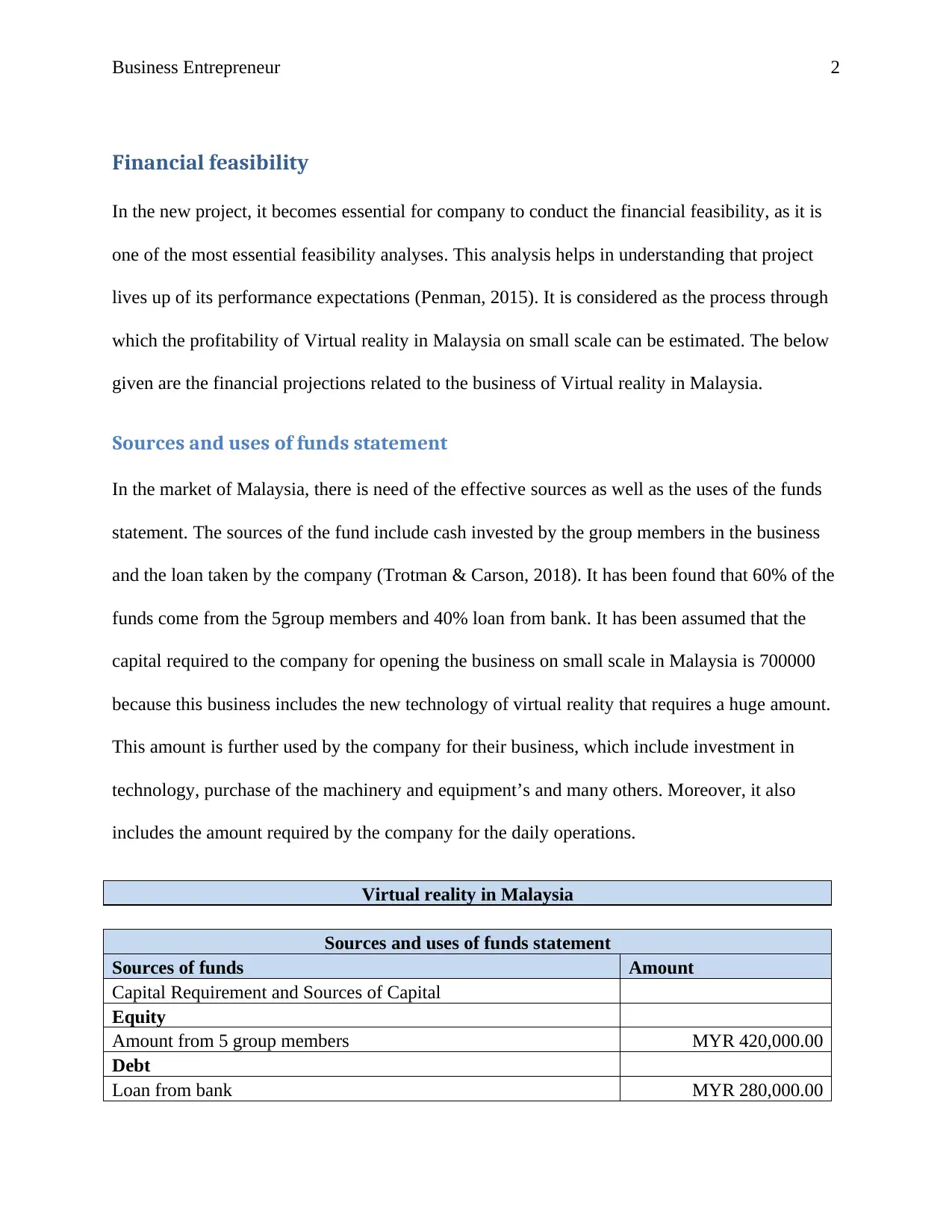
Business Entrepreneur 2
Financial feasibility
In the new project, it becomes essential for company to conduct the financial feasibility, as it is
one of the most essential feasibility analyses. This analysis helps in understanding that project
lives up of its performance expectations (Penman, 2015). It is considered as the process through
which the profitability of Virtual reality in Malaysia on small scale can be estimated. The below
given are the financial projections related to the business of Virtual reality in Malaysia.
Sources and uses of funds statement
In the market of Malaysia, there is need of the effective sources as well as the uses of the funds
statement. The sources of the fund include cash invested by the group members in the business
and the loan taken by the company (Trotman & Carson, 2018). It has been found that 60% of the
funds come from the 5group members and 40% loan from bank. It has been assumed that the
capital required to the company for opening the business on small scale in Malaysia is 700000
because this business includes the new technology of virtual reality that requires a huge amount.
This amount is further used by the company for their business, which include investment in
technology, purchase of the machinery and equipment’s and many others. Moreover, it also
includes the amount required by the company for the daily operations.
Virtual reality in Malaysia
Sources and uses of funds statement
Sources of funds Amount
Capital Requirement and Sources of Capital
Equity
Amount from 5 group members MYR 420,000.00
Debt
Loan from bank MYR 280,000.00
Financial feasibility
In the new project, it becomes essential for company to conduct the financial feasibility, as it is
one of the most essential feasibility analyses. This analysis helps in understanding that project
lives up of its performance expectations (Penman, 2015). It is considered as the process through
which the profitability of Virtual reality in Malaysia on small scale can be estimated. The below
given are the financial projections related to the business of Virtual reality in Malaysia.
Sources and uses of funds statement
In the market of Malaysia, there is need of the effective sources as well as the uses of the funds
statement. The sources of the fund include cash invested by the group members in the business
and the loan taken by the company (Trotman & Carson, 2018). It has been found that 60% of the
funds come from the 5group members and 40% loan from bank. It has been assumed that the
capital required to the company for opening the business on small scale in Malaysia is 700000
because this business includes the new technology of virtual reality that requires a huge amount.
This amount is further used by the company for their business, which include investment in
technology, purchase of the machinery and equipment’s and many others. Moreover, it also
includes the amount required by the company for the daily operations.
Virtual reality in Malaysia
Sources and uses of funds statement
Sources of funds Amount
Capital Requirement and Sources of Capital
Equity
Amount from 5 group members MYR 420,000.00
Debt
Loan from bank MYR 280,000.00
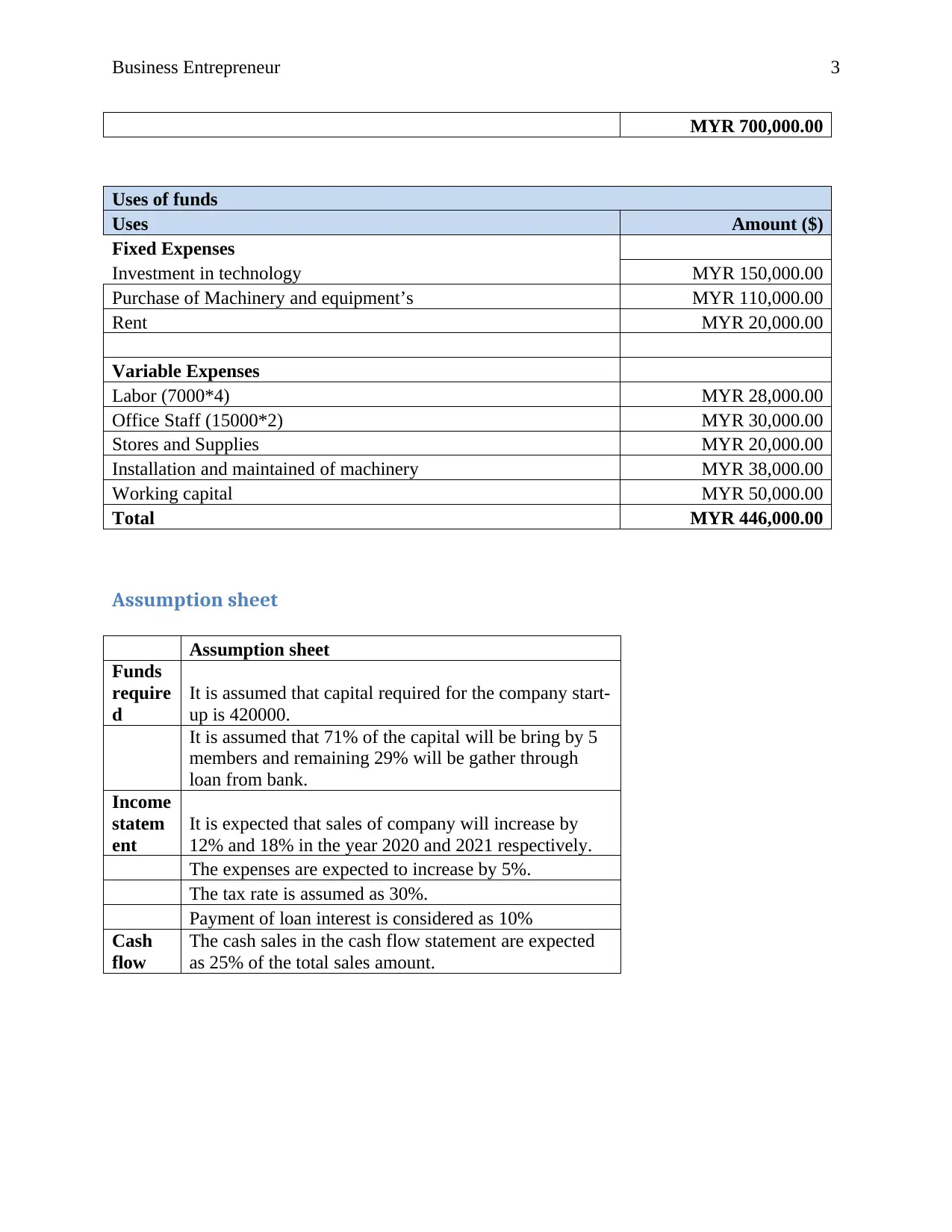
Business Entrepreneur 3
MYR 700,000.00
Uses of funds
Uses Amount ($)
Fixed Expenses
Investment in technology MYR 150,000.00
Purchase of Machinery and equipment’s MYR 110,000.00
Rent MYR 20,000.00
Variable Expenses
Labor (7000*4) MYR 28,000.00
Office Staff (15000*2) MYR 30,000.00
Stores and Supplies MYR 20,000.00
Installation and maintained of machinery MYR 38,000.00
Working capital MYR 50,000.00
Total MYR 446,000.00
Assumption sheet
Assumption sheet
Funds
require
d
It is assumed that capital required for the company start-
up is 420000.
It is assumed that 71% of the capital will be bring by 5
members and remaining 29% will be gather through
loan from bank.
Income
statem
ent
It is expected that sales of company will increase by
12% and 18% in the year 2020 and 2021 respectively.
The expenses are expected to increase by 5%.
The tax rate is assumed as 30%.
Payment of loan interest is considered as 10%
Cash
flow
The cash sales in the cash flow statement are expected
as 25% of the total sales amount.
MYR 700,000.00
Uses of funds
Uses Amount ($)
Fixed Expenses
Investment in technology MYR 150,000.00
Purchase of Machinery and equipment’s MYR 110,000.00
Rent MYR 20,000.00
Variable Expenses
Labor (7000*4) MYR 28,000.00
Office Staff (15000*2) MYR 30,000.00
Stores and Supplies MYR 20,000.00
Installation and maintained of machinery MYR 38,000.00
Working capital MYR 50,000.00
Total MYR 446,000.00
Assumption sheet
Assumption sheet
Funds
require
d
It is assumed that capital required for the company start-
up is 420000.
It is assumed that 71% of the capital will be bring by 5
members and remaining 29% will be gather through
loan from bank.
Income
statem
ent
It is expected that sales of company will increase by
12% and 18% in the year 2020 and 2021 respectively.
The expenses are expected to increase by 5%.
The tax rate is assumed as 30%.
Payment of loan interest is considered as 10%
Cash
flow
The cash sales in the cash flow statement are expected
as 25% of the total sales amount.
Secure Best Marks with AI Grader
Need help grading? Try our AI Grader for instant feedback on your assignments.
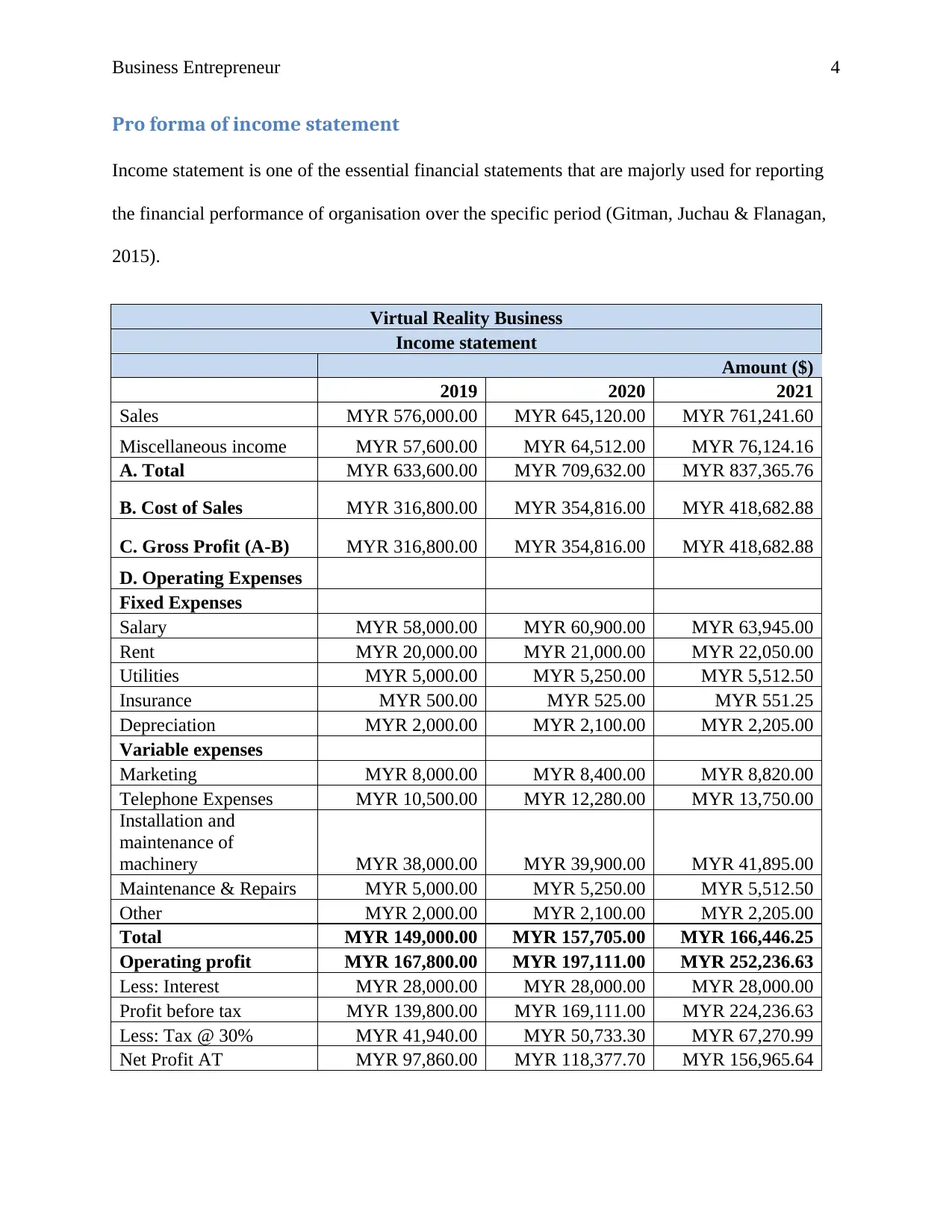
Business Entrepreneur 4
Pro forma of income statement
Income statement is one of the essential financial statements that are majorly used for reporting
the financial performance of organisation over the specific period (Gitman, Juchau & Flanagan,
2015).
Virtual Reality Business
Income statement
Amount ($)
2019 2020 2021
Sales MYR 576,000.00 MYR 645,120.00 MYR 761,241.60
Miscellaneous income MYR 57,600.00 MYR 64,512.00 MYR 76,124.16
A. Total MYR 633,600.00 MYR 709,632.00 MYR 837,365.76
B. Cost of Sales MYR 316,800.00 MYR 354,816.00 MYR 418,682.88
C. Gross Profit (A-B) MYR 316,800.00 MYR 354,816.00 MYR 418,682.88
D. Operating Expenses
Fixed Expenses
Salary MYR 58,000.00 MYR 60,900.00 MYR 63,945.00
Rent MYR 20,000.00 MYR 21,000.00 MYR 22,050.00
Utilities MYR 5,000.00 MYR 5,250.00 MYR 5,512.50
Insurance MYR 500.00 MYR 525.00 MYR 551.25
Depreciation MYR 2,000.00 MYR 2,100.00 MYR 2,205.00
Variable expenses
Marketing MYR 8,000.00 MYR 8,400.00 MYR 8,820.00
Telephone Expenses MYR 10,500.00 MYR 12,280.00 MYR 13,750.00
Installation and
maintenance of
machinery MYR 38,000.00 MYR 39,900.00 MYR 41,895.00
Maintenance & Repairs MYR 5,000.00 MYR 5,250.00 MYR 5,512.50
Other MYR 2,000.00 MYR 2,100.00 MYR 2,205.00
Total MYR 149,000.00 MYR 157,705.00 MYR 166,446.25
Operating profit MYR 167,800.00 MYR 197,111.00 MYR 252,236.63
Less: Interest MYR 28,000.00 MYR 28,000.00 MYR 28,000.00
Profit before tax MYR 139,800.00 MYR 169,111.00 MYR 224,236.63
Less: Tax @ 30% MYR 41,940.00 MYR 50,733.30 MYR 67,270.99
Net Profit AT MYR 97,860.00 MYR 118,377.70 MYR 156,965.64
Pro forma of income statement
Income statement is one of the essential financial statements that are majorly used for reporting
the financial performance of organisation over the specific period (Gitman, Juchau & Flanagan,
2015).
Virtual Reality Business
Income statement
Amount ($)
2019 2020 2021
Sales MYR 576,000.00 MYR 645,120.00 MYR 761,241.60
Miscellaneous income MYR 57,600.00 MYR 64,512.00 MYR 76,124.16
A. Total MYR 633,600.00 MYR 709,632.00 MYR 837,365.76
B. Cost of Sales MYR 316,800.00 MYR 354,816.00 MYR 418,682.88
C. Gross Profit (A-B) MYR 316,800.00 MYR 354,816.00 MYR 418,682.88
D. Operating Expenses
Fixed Expenses
Salary MYR 58,000.00 MYR 60,900.00 MYR 63,945.00
Rent MYR 20,000.00 MYR 21,000.00 MYR 22,050.00
Utilities MYR 5,000.00 MYR 5,250.00 MYR 5,512.50
Insurance MYR 500.00 MYR 525.00 MYR 551.25
Depreciation MYR 2,000.00 MYR 2,100.00 MYR 2,205.00
Variable expenses
Marketing MYR 8,000.00 MYR 8,400.00 MYR 8,820.00
Telephone Expenses MYR 10,500.00 MYR 12,280.00 MYR 13,750.00
Installation and
maintenance of
machinery MYR 38,000.00 MYR 39,900.00 MYR 41,895.00
Maintenance & Repairs MYR 5,000.00 MYR 5,250.00 MYR 5,512.50
Other MYR 2,000.00 MYR 2,100.00 MYR 2,205.00
Total MYR 149,000.00 MYR 157,705.00 MYR 166,446.25
Operating profit MYR 167,800.00 MYR 197,111.00 MYR 252,236.63
Less: Interest MYR 28,000.00 MYR 28,000.00 MYR 28,000.00
Profit before tax MYR 139,800.00 MYR 169,111.00 MYR 224,236.63
Less: Tax @ 30% MYR 41,940.00 MYR 50,733.30 MYR 67,270.99
Net Profit AT MYR 97,860.00 MYR 118,377.70 MYR 156,965.64
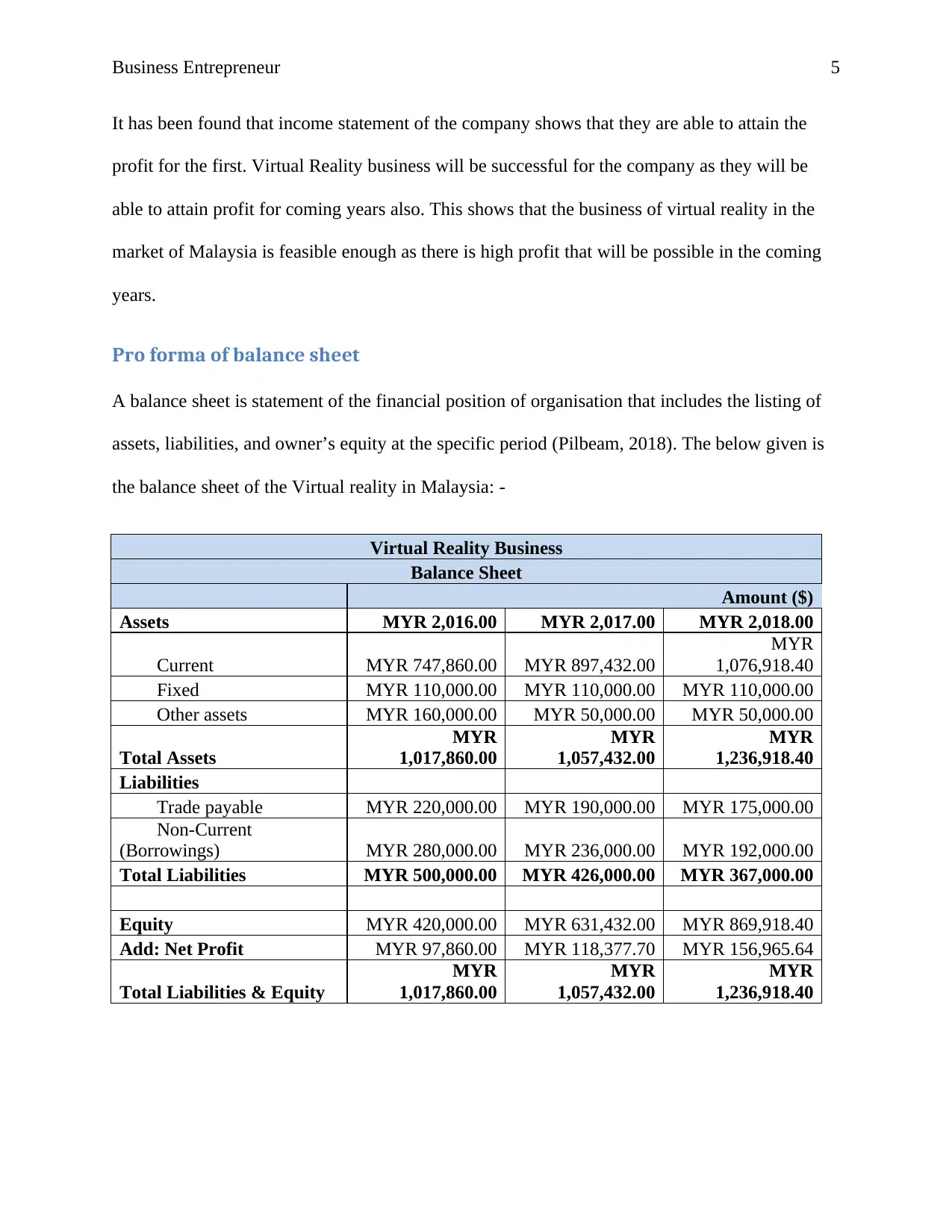
Business Entrepreneur 5
It has been found that income statement of the company shows that they are able to attain the
profit for the first. Virtual Reality business will be successful for the company as they will be
able to attain profit for coming years also. This shows that the business of virtual reality in the
market of Malaysia is feasible enough as there is high profit that will be possible in the coming
years.
Pro forma of balance sheet
A balance sheet is statement of the financial position of organisation that includes the listing of
assets, liabilities, and owner’s equity at the specific period (Pilbeam, 2018). The below given is
the balance sheet of the Virtual reality in Malaysia: -
Virtual Reality Business
Balance Sheet
Amount ($)
Assets MYR 2,016.00 MYR 2,017.00 MYR 2,018.00
Current MYR 747,860.00 MYR 897,432.00
MYR
1,076,918.40
Fixed MYR 110,000.00 MYR 110,000.00 MYR 110,000.00
Other assets MYR 160,000.00 MYR 50,000.00 MYR 50,000.00
Total Assets
MYR
1,017,860.00
MYR
1,057,432.00
MYR
1,236,918.40
Liabilities
Trade payable MYR 220,000.00 MYR 190,000.00 MYR 175,000.00
Non-Current
(Borrowings) MYR 280,000.00 MYR 236,000.00 MYR 192,000.00
Total Liabilities MYR 500,000.00 MYR 426,000.00 MYR 367,000.00
Equity MYR 420,000.00 MYR 631,432.00 MYR 869,918.40
Add: Net Profit MYR 97,860.00 MYR 118,377.70 MYR 156,965.64
Total Liabilities & Equity
MYR
1,017,860.00
MYR
1,057,432.00
MYR
1,236,918.40
It has been found that income statement of the company shows that they are able to attain the
profit for the first. Virtual Reality business will be successful for the company as they will be
able to attain profit for coming years also. This shows that the business of virtual reality in the
market of Malaysia is feasible enough as there is high profit that will be possible in the coming
years.
Pro forma of balance sheet
A balance sheet is statement of the financial position of organisation that includes the listing of
assets, liabilities, and owner’s equity at the specific period (Pilbeam, 2018). The below given is
the balance sheet of the Virtual reality in Malaysia: -
Virtual Reality Business
Balance Sheet
Amount ($)
Assets MYR 2,016.00 MYR 2,017.00 MYR 2,018.00
Current MYR 747,860.00 MYR 897,432.00
MYR
1,076,918.40
Fixed MYR 110,000.00 MYR 110,000.00 MYR 110,000.00
Other assets MYR 160,000.00 MYR 50,000.00 MYR 50,000.00
Total Assets
MYR
1,017,860.00
MYR
1,057,432.00
MYR
1,236,918.40
Liabilities
Trade payable MYR 220,000.00 MYR 190,000.00 MYR 175,000.00
Non-Current
(Borrowings) MYR 280,000.00 MYR 236,000.00 MYR 192,000.00
Total Liabilities MYR 500,000.00 MYR 426,000.00 MYR 367,000.00
Equity MYR 420,000.00 MYR 631,432.00 MYR 869,918.40
Add: Net Profit MYR 97,860.00 MYR 118,377.70 MYR 156,965.64
Total Liabilities & Equity
MYR
1,017,860.00
MYR
1,057,432.00
MYR
1,236,918.40

Business Entrepreneur 6
Pro forma of cash flows
The cash flow statement is prepared which include the cash inflows and outflows of the business.
This statement has been prepared by the company to reflect any changes within the income and
accounts affect cash as well as cash equivalents that break the analysis to operating, investing, as
well as financing activities (Arvanitis & Estevez, 2018). This analysis helps the virtual reality
business to manage the sufficient amount of cash among all the times because a firm requires
cash at any movement of time.
Virtual Reality Business
Cash Flow Statement
Amount ($)
2019 2020 2021
Cash Flow from
Operating Activities
Cash sales 144,000 161,280 190,310
Realization from Debtors 216,000 241,920 285,466
Payment to Creditors (120,000) (138,000) (158,700)
Expenses paid (465,800) (386,349) (469,644)
Total (225,800) (121,149) (152,568)
Cash Flow from
Investing Activities
Machinery Purchased (110,000) - -
Installation and
maintenance of
machinery (38,000) - -
Total (148,000) - -
Pro forma of cash flows
The cash flow statement is prepared which include the cash inflows and outflows of the business.
This statement has been prepared by the company to reflect any changes within the income and
accounts affect cash as well as cash equivalents that break the analysis to operating, investing, as
well as financing activities (Arvanitis & Estevez, 2018). This analysis helps the virtual reality
business to manage the sufficient amount of cash among all the times because a firm requires
cash at any movement of time.
Virtual Reality Business
Cash Flow Statement
Amount ($)
2019 2020 2021
Cash Flow from
Operating Activities
Cash sales 144,000 161,280 190,310
Realization from Debtors 216,000 241,920 285,466
Payment to Creditors (120,000) (138,000) (158,700)
Expenses paid (465,800) (386,349) (469,644)
Total (225,800) (121,149) (152,568)
Cash Flow from
Investing Activities
Machinery Purchased (110,000) - -
Installation and
maintenance of
machinery (38,000) - -
Total (148,000) - -
Paraphrase This Document
Need a fresh take? Get an instant paraphrase of this document with our AI Paraphraser
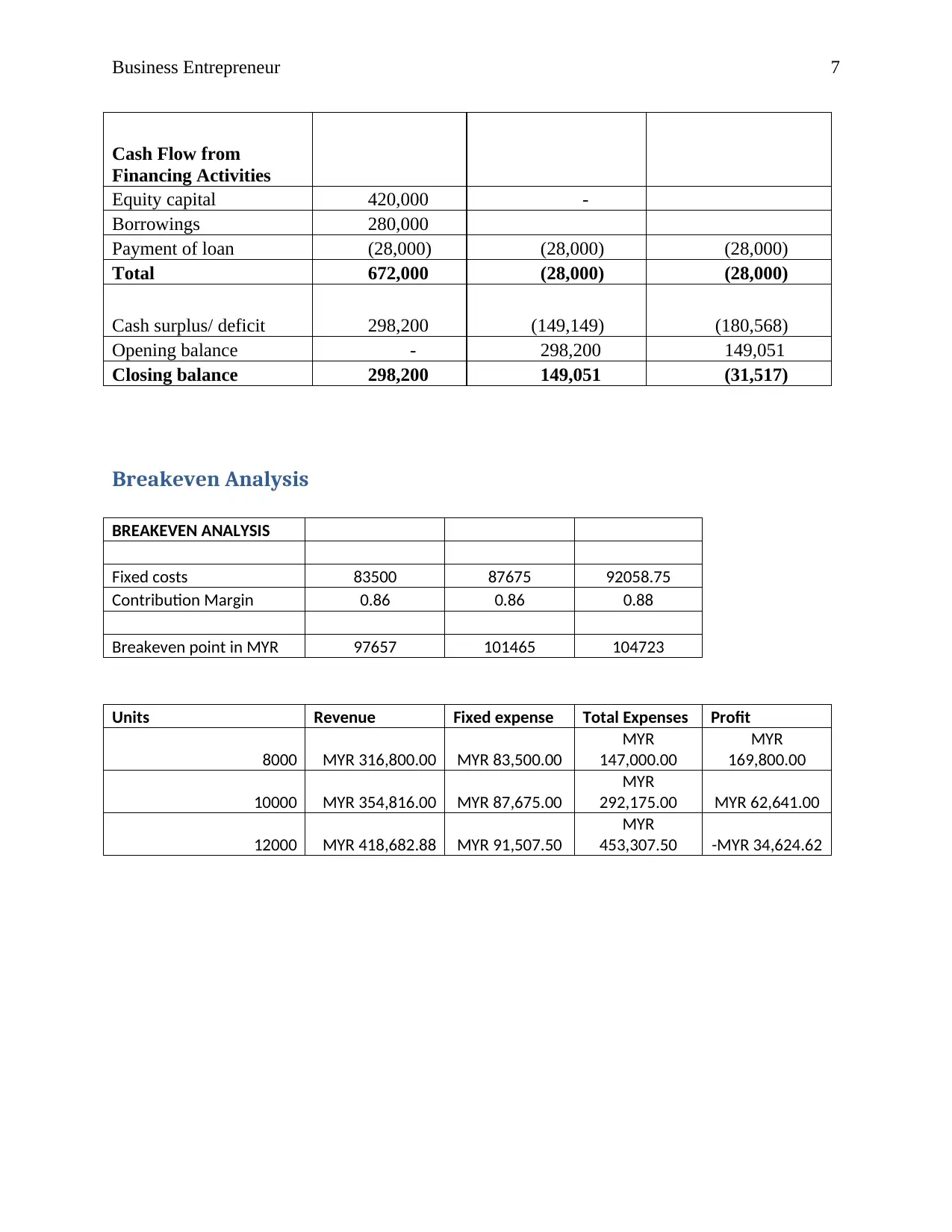
Business Entrepreneur 7
Cash Flow from
Financing Activities
Equity capital 420,000 -
Borrowings 280,000
Payment of loan (28,000) (28,000) (28,000)
Total 672,000 (28,000) (28,000)
Cash surplus/ deficit 298,200 (149,149) (180,568)
Opening balance - 298,200 149,051
Closing balance 298,200 149,051 (31,517)
Breakeven Analysis
BREAKEVEN ANALYSIS
Fixed costs 83500 87675 92058.75
Contribution Margin 0.86 0.86 0.88
Breakeven point in MYR 97657 101465 104723
Units Revenue Fixed expense Total Expenses Profit
8000 MYR 316,800.00 MYR 83,500.00
MYR
147,000.00
MYR
169,800.00
10000 MYR 354,816.00 MYR 87,675.00
MYR
292,175.00 MYR 62,641.00
12000 MYR 418,682.88 MYR 91,507.50
MYR
453,307.50 -MYR 34,624.62
Cash Flow from
Financing Activities
Equity capital 420,000 -
Borrowings 280,000
Payment of loan (28,000) (28,000) (28,000)
Total 672,000 (28,000) (28,000)
Cash surplus/ deficit 298,200 (149,149) (180,568)
Opening balance - 298,200 149,051
Closing balance 298,200 149,051 (31,517)
Breakeven Analysis
BREAKEVEN ANALYSIS
Fixed costs 83500 87675 92058.75
Contribution Margin 0.86 0.86 0.88
Breakeven point in MYR 97657 101465 104723
Units Revenue Fixed expense Total Expenses Profit
8000 MYR 316,800.00 MYR 83,500.00
MYR
147,000.00
MYR
169,800.00
10000 MYR 354,816.00 MYR 87,675.00
MYR
292,175.00 MYR 62,641.00
12000 MYR 418,682.88 MYR 91,507.50
MYR
453,307.50 -MYR 34,624.62
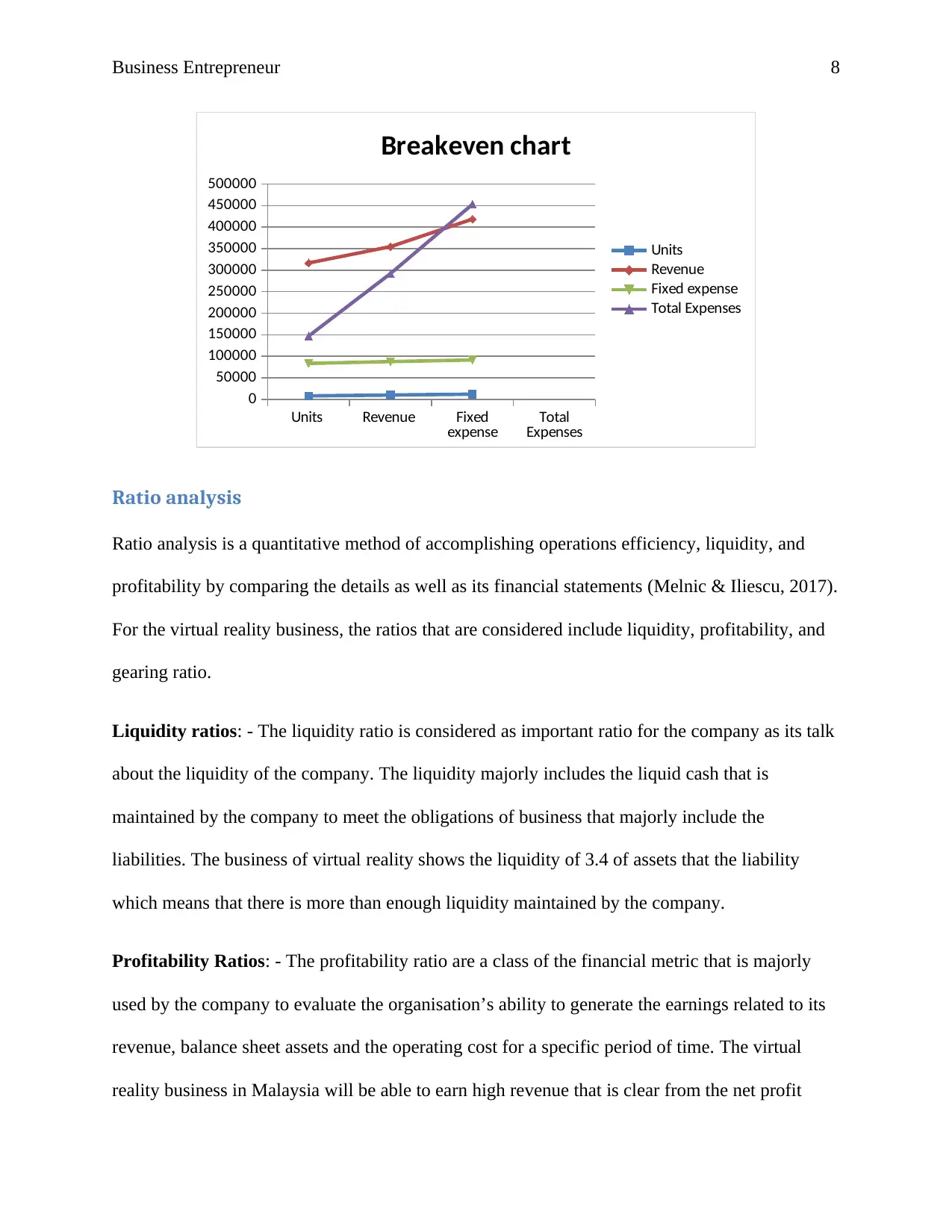
Business Entrepreneur 8
Units Revenue Fixed
expense Total
Expenses
0
50000
100000
150000
200000
250000
300000
350000
400000
450000
500000
Breakeven chart
Units
Revenue
Fixed expense
Total Expenses
Ratio analysis
Ratio analysis is a quantitative method of accomplishing operations efficiency, liquidity, and
profitability by comparing the details as well as its financial statements (Melnic & Iliescu, 2017).
For the virtual reality business, the ratios that are considered include liquidity, profitability, and
gearing ratio.
Liquidity ratios: - The liquidity ratio is considered as important ratio for the company as its talk
about the liquidity of the company. The liquidity majorly includes the liquid cash that is
maintained by the company to meet the obligations of business that majorly include the
liabilities. The business of virtual reality shows the liquidity of 3.4 of assets that the liability
which means that there is more than enough liquidity maintained by the company.
Profitability Ratios: - The profitability ratio are a class of the financial metric that is majorly
used by the company to evaluate the organisation’s ability to generate the earnings related to its
revenue, balance sheet assets and the operating cost for a specific period of time. The virtual
reality business in Malaysia will be able to earn high revenue that is clear from the net profit
Units Revenue Fixed
expense Total
Expenses
0
50000
100000
150000
200000
250000
300000
350000
400000
450000
500000
Breakeven chart
Units
Revenue
Fixed expense
Total Expenses
Ratio analysis
Ratio analysis is a quantitative method of accomplishing operations efficiency, liquidity, and
profitability by comparing the details as well as its financial statements (Melnic & Iliescu, 2017).
For the virtual reality business, the ratios that are considered include liquidity, profitability, and
gearing ratio.
Liquidity ratios: - The liquidity ratio is considered as important ratio for the company as its talk
about the liquidity of the company. The liquidity majorly includes the liquid cash that is
maintained by the company to meet the obligations of business that majorly include the
liabilities. The business of virtual reality shows the liquidity of 3.4 of assets that the liability
which means that there is more than enough liquidity maintained by the company.
Profitability Ratios: - The profitability ratio are a class of the financial metric that is majorly
used by the company to evaluate the organisation’s ability to generate the earnings related to its
revenue, balance sheet assets and the operating cost for a specific period of time. The virtual
reality business in Malaysia will be able to earn high revenue that is clear from the net profit
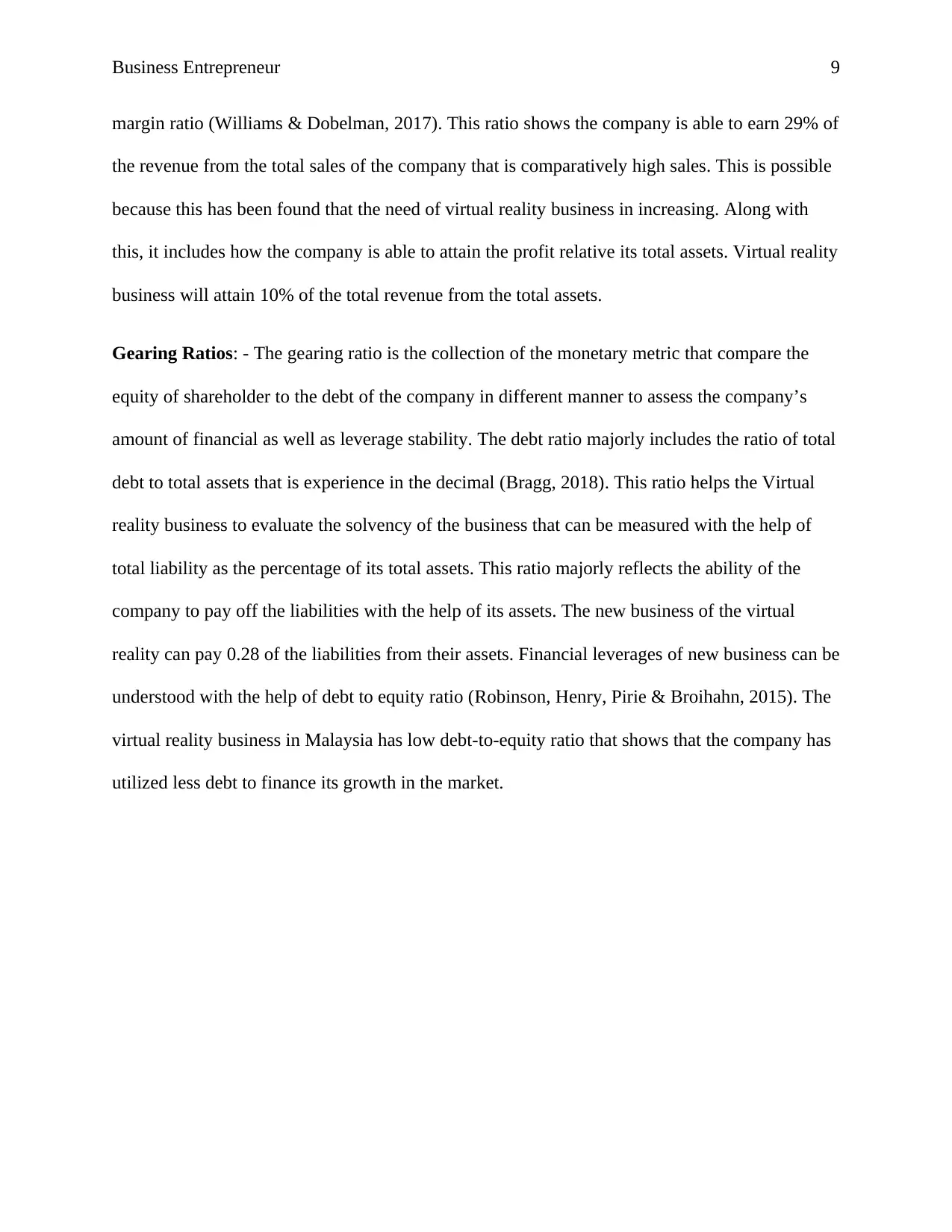
Business Entrepreneur 9
margin ratio (Williams & Dobelman, 2017). This ratio shows the company is able to earn 29% of
the revenue from the total sales of the company that is comparatively high sales. This is possible
because this has been found that the need of virtual reality business in increasing. Along with
this, it includes how the company is able to attain the profit relative its total assets. Virtual reality
business will attain 10% of the total revenue from the total assets.
Gearing Ratios: - The gearing ratio is the collection of the monetary metric that compare the
equity of shareholder to the debt of the company in different manner to assess the company’s
amount of financial as well as leverage stability. The debt ratio majorly includes the ratio of total
debt to total assets that is experience in the decimal (Bragg, 2018). This ratio helps the Virtual
reality business to evaluate the solvency of the business that can be measured with the help of
total liability as the percentage of its total assets. This ratio majorly reflects the ability of the
company to pay off the liabilities with the help of its assets. The new business of the virtual
reality can pay 0.28 of the liabilities from their assets. Financial leverages of new business can be
understood with the help of debt to equity ratio (Robinson, Henry, Pirie & Broihahn, 2015). The
virtual reality business in Malaysia has low debt-to-equity ratio that shows that the company has
utilized less debt to finance its growth in the market.
margin ratio (Williams & Dobelman, 2017). This ratio shows the company is able to earn 29% of
the revenue from the total sales of the company that is comparatively high sales. This is possible
because this has been found that the need of virtual reality business in increasing. Along with
this, it includes how the company is able to attain the profit relative its total assets. Virtual reality
business will attain 10% of the total revenue from the total assets.
Gearing Ratios: - The gearing ratio is the collection of the monetary metric that compare the
equity of shareholder to the debt of the company in different manner to assess the company’s
amount of financial as well as leverage stability. The debt ratio majorly includes the ratio of total
debt to total assets that is experience in the decimal (Bragg, 2018). This ratio helps the Virtual
reality business to evaluate the solvency of the business that can be measured with the help of
total liability as the percentage of its total assets. This ratio majorly reflects the ability of the
company to pay off the liabilities with the help of its assets. The new business of the virtual
reality can pay 0.28 of the liabilities from their assets. Financial leverages of new business can be
understood with the help of debt to equity ratio (Robinson, Henry, Pirie & Broihahn, 2015). The
virtual reality business in Malaysia has low debt-to-equity ratio that shows that the company has
utilized less debt to finance its growth in the market.
Secure Best Marks with AI Grader
Need help grading? Try our AI Grader for instant feedback on your assignments.
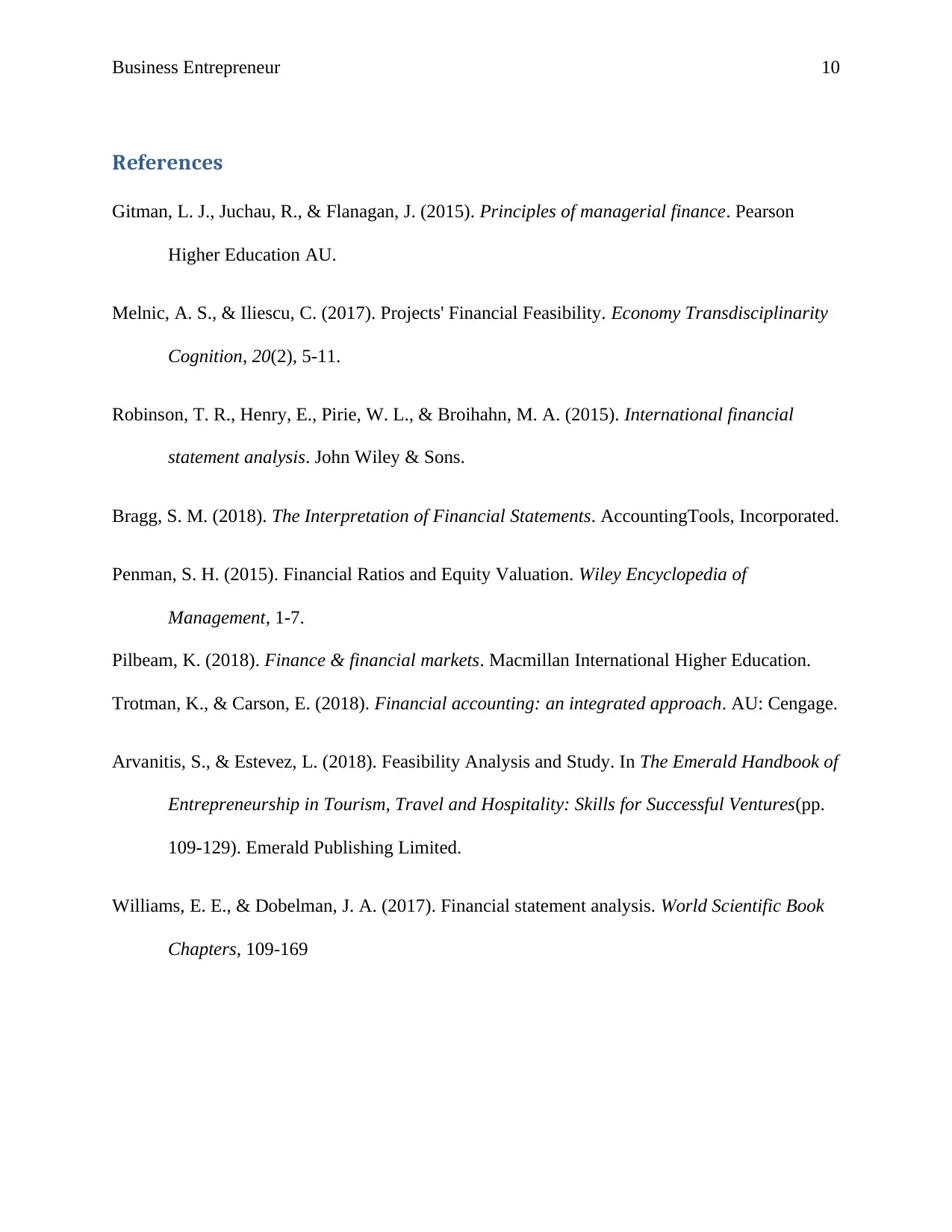
Business Entrepreneur 10
References
Gitman, L. J., Juchau, R., & Flanagan, J. (2015). Principles of managerial finance. Pearson
Higher Education AU.
Melnic, A. S., & Iliescu, C. (2017). Projects' Financial Feasibility. Economy Transdisciplinarity
Cognition, 20(2), 5-11.
Robinson, T. R., Henry, E., Pirie, W. L., & Broihahn, M. A. (2015). International financial
statement analysis. John Wiley & Sons.
Bragg, S. M. (2018). The Interpretation of Financial Statements. AccountingTools, Incorporated.
Penman, S. H. (2015). Financial Ratios and Equity Valuation. Wiley Encyclopedia of
Management, 1-7.
Pilbeam, K. (2018). Finance & financial markets. Macmillan International Higher Education.
Trotman, K., & Carson, E. (2018). Financial accounting: an integrated approach. AU: Cengage.
Arvanitis, S., & Estevez, L. (2018). Feasibility Analysis and Study. In The Emerald Handbook of
Entrepreneurship in Tourism, Travel and Hospitality: Skills for Successful Ventures(pp.
109-129). Emerald Publishing Limited.
Williams, E. E., & Dobelman, J. A. (2017). Financial statement analysis. World Scientific Book
Chapters, 109-169
References
Gitman, L. J., Juchau, R., & Flanagan, J. (2015). Principles of managerial finance. Pearson
Higher Education AU.
Melnic, A. S., & Iliescu, C. (2017). Projects' Financial Feasibility. Economy Transdisciplinarity
Cognition, 20(2), 5-11.
Robinson, T. R., Henry, E., Pirie, W. L., & Broihahn, M. A. (2015). International financial
statement analysis. John Wiley & Sons.
Bragg, S. M. (2018). The Interpretation of Financial Statements. AccountingTools, Incorporated.
Penman, S. H. (2015). Financial Ratios and Equity Valuation. Wiley Encyclopedia of
Management, 1-7.
Pilbeam, K. (2018). Finance & financial markets. Macmillan International Higher Education.
Trotman, K., & Carson, E. (2018). Financial accounting: an integrated approach. AU: Cengage.
Arvanitis, S., & Estevez, L. (2018). Feasibility Analysis and Study. In The Emerald Handbook of
Entrepreneurship in Tourism, Travel and Hospitality: Skills for Successful Ventures(pp.
109-129). Emerald Publishing Limited.
Williams, E. E., & Dobelman, J. A. (2017). Financial statement analysis. World Scientific Book
Chapters, 109-169
1 out of 11
Related Documents
Your All-in-One AI-Powered Toolkit for Academic Success.
+13062052269
info@desklib.com
Available 24*7 on WhatsApp / Email
![[object Object]](/_next/static/media/star-bottom.7253800d.svg)
Unlock your academic potential
© 2024 | Zucol Services PVT LTD | All rights reserved.





